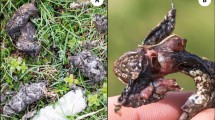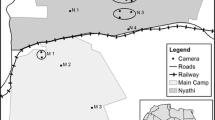Abstract
Studies focused on how prey trade-off predation and starvation risk are prevalent in behavioral ecology. However, our current understanding of these trade-offs is limited in one key respect: we know little about the behavior of predators. In this study, we provide some of the first detailed information on temporal patterns in the daily hunting behavior of bird-eating Accipiter hawks and relate that to their prey. During the winters of 1999–2004, twenty-one sharp-shinned hawks (A. striatus) and ten Cooper’s hawks (A. cooperii) were intensively radio tracked in rural and urban habitats in western Indiana, USA. Cooper’s hawks left roost before sunrise and usually returned to roost around sunset, while sharp-shinned hawks left roost at sunrise or later and returned to roost well before sunset. An overall measure of Cooper’s-hawk-induced risk (a composite variable of attack rate and activity patterns) generally reflected the timing of prey activity, with peaks occurring around sunrise and sunset. In contrast, risk induced by the smaller sharp-shinned hawk did not strongly reflect the activity of their prey. Specifically, an early morning peak in prey activity did not correspond to a period with intense hawk activity. The lack of early morning hunting by sharp-shinned hawks may reflect the high risk of owl-induced predation experienced by these hawks. The net effect of this intraguild predation may be to “free” small birds from much hawk-induced predation risk prior to sunrise. This realization presents an alternative to energetics as an explanation for the early morning peak in small bird activity during the winter.





Similar content being viewed by others
References
Beauchamp G (1999) The evolution of communal roosting in birds: origin and secondary losses. Behav Ecol 10:675–687
Berger DD, Mueller HC (1959) The bal-chatri: a trap for the birds of prey. Bird-Banding 30:18–26
Bertram BCR (1978) Living in groups: predators and prey. In: Krebs JR, Davies NB (eds) Behavioural ecology. Blackwell, London, pp 279–309
Bibby CJ, Burgess ND, Hill DA (1992) Bird census techniques. Academic Press, London
Bildstein KL, Meyer K (2000) Sharp-shinned hawk (Accipiter striatus), vol 482. The birds of North America, Philadelphia, Pa.
Brown JS, Laundre JW, Gurung M (1999) The ecology of fear: optimal foraging, game theory, and trophic interactions. J Mammal 80:385–399
Bouskila A (1995) Interactions between predation risk and competition: a field study of kangaroo rats and snakes. Ecology 71:165–178
Caro T (2005) Antipredator defenses in birds and mammals. University of Chicago Press, Chicago, Ill.
Creel S, Winnie JA (2005) Responses of elk herd size to fine-scale spatial and temporal variation in the risk of predation by wolves. Anim Behav 69:1181–1189
Cresswell W (1994a) Flocking as an effective anti-predation strategy in redshanks, Tringa totanus. Anim Behav 47:433–442
Cresswell W (1994b) Age-dependent choice of redshank (Tringa totanus) feeding location—profitability or risk. J Anim Ecol 63:589–600
Cresswell W (1996) Surprise as a winter hunting strategy in sparrowhawks Accipiter nisus, peregrines Falco peregrinus, and merlins, F. columbarius. Ibis 138:684–692
Cromrich LA, Holt DW, Leasure SM (2002) Trophic niche of North American great horned owls. J Raptor Res 36:58–65
Cuthill IC, Houston AI (1997) Managing time and energy. In: Krebs JR, Davies NB (eds) Behavioural ecology. Blackwell, London, pp 97–120
Dunn EH, Tessaglia DL (1994) Predation of birds at feeders in winter. J Field Ornith 65:8–16
Earhart CM, Johnson NK (1970) Size dimorphism and food habits of North American owls. Condor 72:251–264
Fiksen O, Giske J (1995) Vertical distribution and population dynamics of copepods by dynamic optimization. J Mar Sci 52:483–503
Fortin D, Beyer HL, Boyce MS, Smith DW, Duchesne T, Mao JS (2005) Wolves influence elk movements: behavior shapes a trophic cascade in Yellowstone National Park. Ecology 86:1320–1330
Giraldeau L-A, Caraco T (2000) Social foraging theory. Princeton University Press, Princeton, N.J.
Houston A, McNamara J (1999) Models of adaptive behavior. Cambridge University Press, Cambridge
Hugie DM (2003) The waiting game: a “battle of waits” between predator and prey. Behav Ecol 14:807–817
Kenward RE (1978) Hawks and doves: factors affecting success and selection in goshawk attacks on woodpigeons. J Anim Ecol 47:449–460
Kotler BP, Brown JS, Hasson O (1991) Factors affecting gerbil foraging behavior and rates of owl predation. Ecology 72:2249–2260
Kotler BP, Ayal Y, Subach A (1994) Effects of predatory risk and resource renewal on the timing of foraging activity in a gerbil community. Oecologia 100:391–396
Kotler BP, Brown JS, Dall SRX, Gresser S, Ganey D, Bouskila A (2002) Foraging games between gerbils and their predators: temporal dynamics of resource depletion and apprehension in gerbils. Evol Ecol Res 4:495–518
Kronfeld-Schor N, Dayan T (2003) Partitioning of time as an ecological resource. Annu Rev Ecol Syst 34:153–181
Lampert W (1989) The adaptive significance of diel vertical migration of zooplankton. Func Ecol 3:21–27
Lima SL (1985) Maximizing feeding efficiency and minimizing time exposed to predators: a trade-off in the black-capped chickadee. Oecologia 66:60–67
Lima SL (1998) Stress and decision making under the risk of predation: recent developments from behavioral, reproductive, and ecological perspectives. Adv Study Behav 27:215–290
Lima SL (2002) Putting predators back into behavioral predator–prey interactions. Trends Ecol Evol 17:70–75
Lind JT, Fransson T, Jakobsson S, Kullberg C (1999) Reduced take-off ability in Robins (Erithacus rubecula) due to migratory fuel load. Behav Ecol Socio 46:65–70
Lind JT, Cresswell W (2005) Determining the fitness consequences of antipredation behavior. Behav Ecol 16:945–956
Mangel M, Clark CW (1988) Dynamic modeling in behavioral ecology. Princeton University Press, Princeton , N.J.
Marks JS, Hendricks DP, Marks VS (1984) Winter food habits of barred owls in Western Montana. Murrelet 65:27–28
McNamara JM, Houston AI, Lima SL (1994) Foraging routines of small birds in winter—a theoretical investigation. J Avian Biol 25:287–302
Mitchell WA, Lima SL (2002) Predator–prey shell games: large-scale movement and its implications for decision-making by prey. Oikos 99:249–260
Newton I (1986) The sparrowhawk. Poyser, T & AD, London
Orrock JL, Danielson BJ, Burns MJ, Levey DJ (2003) Spatial ecology of predator–prey interactions: corridors and patch shape influence seed predation. Ecology 84:2589–2599
Peacor SD, Werner EE (2000) Predator effects on an assemblage of consumer through induced changes in consumer foraging behavior. Ecology 81:1998–2010
Pravosudov VV, Grubb TC (1997) Management of fat reserves and food caches in tufted titmice (Parus bicolor) in relation to unpredictable food supply. Behav Ecol 8:332–339
Pulliam HR, Caraco T (1984) Living in groups: is there an optimal group size? In: Krebs JR, Davies NB (eds) Behavioural ecology. Blackwell, London, pp 127–147
Rappole JH, Tipton AR (1994) New harness design for attachment of radio transmitters to small passerines. J Field Ornithol 62:335–337
Rosenfield RN, Bielefeldt J (1993) Cooper’s hawk (Accipiter cooperii), vol 75. The birds of North America, Philadelphia, Pa.
Roth TC, Lima SL (2003) Hunting behavior and diet of Cooper’s hawks: an urban view of the small-bird-in-winter paradigm. Condor 105:474–483
Roth TC, Lima SL (2006a). Predatory behavior of wintering Cooper’s hawks in a rural habitat. J Raptor Res 40(4)
Roth TC, Lima SL (2006b) Use of prey hotspots by an avian predator: purposeful unpredictability? Am Nat (in press)
Roth TC, Lima SL, Vetter WE (2005) Survival and causes of mortality in wintering sharp-shinned and Cooper’s hawks. Wilson Bull 117:237–244
Roth TC, Lima SL, Vetter WE (2006) Determinants of predation risk in small wintering birds: the hawk’s perspective. Behav Ecol Soc 60:195–204
Rydell J, Entwistle A, Racey PA (1996) Timing of foraging flights of three species of bats in relation to insect activity and predation risk. Oikos 76:243–252
Schmitz OJ, Krivan V, Ovadia O (2004) Trophic cascades: the primacy of trait-mediated indirect interactions. Ecol Lett 7:153–163
Sih A (1992) Prey uncertainty and the balancing of antipredator and feeding needs. Am Nat 139:1052–1069
SPSS (1998) SYSTAT 10.0 for windows. SPSS
Stephens DW, Krebs JR (1986) Foraging theory. Princeton University Press, Princeton, N.J.
Van der Veen IT (2000) Daily routines and predator encounters in yellowhammers Emberiza citronella in the field during winter. Ibis 142:413–420
Whitfield DP, Cresswell W, Ashmole NP, Clark NA, Evans AD (1999) No evidence for sparrowhawk selecting redshanks according to size or condition. J Avian Biol 30:31–39
White GC, Garrott RA (1990) Analysis of wildlife radio-tagging data. Academic Press, San Diego, Calif.
Acknowledgements
We thank Bill Vetter, Trey Franklin, and our many field technicians for their assistance with hawk tracking. Mike Russell provided assistance with information on owl diet. We would also like to thank local businesses, land owners (especially M. Evrard, J. Irwin, C. Martin, and C. Miller), and the Terre Haute Parks Department for their cooperation. John Castrale, Burt Kotler, Peter Scott, and anonymous reviewers provided helpful comments on drafts of this paper. This research was supported in part by the National Science Foundation (grant IBN-0130758), the Indiana Academy of Sciences, and the Indiana State University Department of Ecology and Organismal Biology and School of Graduate Studies. This research adhered to guidelines for the use of animals in research, was reviewed and approved by the Institutional Animal Care and Use Committee at Indiana State University, and followed all federal and state regulations for the collection and marking of wild animals.
Author information
Authors and Affiliations
Corresponding author
Additional information
Communicated by Steven Kohler.
Rights and permissions
About this article
Cite this article
Roth, T.C., Lima, S.L. The predatory behavior of wintering Accipiter hawks: temporal patterns in activity of predators and prey. Oecologia 152, 169–178 (2007). https://doi.org/10.1007/s00442-006-0638-2
Received:
Accepted:
Published:
Issue Date:
DOI: https://doi.org/10.1007/s00442-006-0638-2




